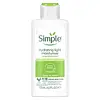What's inside
What's inside
 Key Ingredients
Key Ingredients

 Benefits
Benefits

 Concerns
Concerns

 Ingredients Side-by-side
Ingredients Side-by-side

Water
Skin ConditioningGlycerin
HumectantSodium Acrylate/Sodium Acryloyldimethyl Taurate Copolymer
Emulsion StabilisingHydrogenated Polydecene
EmollientTrideceth-6
EmulsifyingSorbitan Laurate
EmulsifyingCetearyl Alcohol
EmollientCaprylic/Capric Triglyceride
MaskingSaccharide Isomerate
HumectantCitric Acid
BufferingSodium Citrate
BufferingBehenyl Alcohol
EmollientSorbitan Stearate
EmulsifyingSucrose Cocoate
EmulsifyingDicetyl Phosphate
EmulsifyingCeteth-10 Phosphate
CleansingCyclopentasiloxane
EmollientPhenyl Trimethicone
Skin ConditioningDimethiconol
EmollientC12-15 Alkyl Benzoate
AntimicrobialDimethicone Crosspolymer
Emulsion StabilisingPhenoxyethanol
PreservativeEthylhexylglycerin
Skin ConditioningXylitylglucoside
HumectantAnhydroxylitol
HumectantXylitol
HumectantAvena Sativa Kernel Flour
AbrasiveSodium Hyaluronate
HumectantPanthenol
Skin ConditioningCeramide 3
Skin ConditioningCeramide 6 Ii
Skin ConditioningCeramide 1
Skin ConditioningPhytosphingosine
Skin ConditioningCholesterol
EmollientSodium Lauroyl Lactylate
EmulsifyingCarbomer
Emulsion StabilisingXanthan Gum
EmulsifyingDipentaerythrityl Tetrahydroxystearate/Tetraisostearate
Skin ConditioningWater, Glycerin, Sodium Acrylate/Sodium Acryloyldimethyl Taurate Copolymer, Hydrogenated Polydecene, Trideceth-6, Sorbitan Laurate, Cetearyl Alcohol, Caprylic/Capric Triglyceride, Saccharide Isomerate, Citric Acid, Sodium Citrate, Behenyl Alcohol, Sorbitan Stearate, Sucrose Cocoate, Dicetyl Phosphate, Ceteth-10 Phosphate, Cyclopentasiloxane, Phenyl Trimethicone, Dimethiconol, C12-15 Alkyl Benzoate, Dimethicone Crosspolymer, Phenoxyethanol, Ethylhexylglycerin, Xylitylglucoside, Anhydroxylitol, Xylitol, Avena Sativa Kernel Flour, Sodium Hyaluronate, Panthenol, Ceramide 3, Ceramide 6 Ii, Ceramide 1, Phytosphingosine, Cholesterol, Sodium Lauroyl Lactylate, Carbomer, Xanthan Gum, Dipentaerythrityl Tetrahydroxystearate/Tetraisostearate
Water
Skin ConditioningGlycerin
HumectantParaffinum Liquidum
EmollientPolyglyceryl-3 Methylglucose Distearate
EmulsifyingCetyl Palmitate
EmollientDimethicone
EmollientPanthenol
Skin ConditioningTocopheryl Acetate
AntioxidantBorago Officinalis Seed Oil
EmollientPantolactone
HumectantBisabolol
MaskingSodium Lactate
BufferingLactic Acid
BufferingSerine
MaskingUrea
BufferingSorbitol
HumectantAllantoin
Skin ConditioningSodium Chloride
MaskingPotassium Hydroxide
BufferingCarbomer
Emulsion StabilisingAcrylates/C10-30 Alkyl Acrylate Crosspolymer
Emulsion StabilisingCetyl Alcohol
EmollientPentylene Glycol
Skin ConditioningDisodium EDTA
Methylparaben
PreservativePropylparaben
Preservative2-Bromo-2-Nitropropane-1,3-Diol
PreservativeMica
Cosmetic ColorantTitanium Dioxide
Cosmetic ColorantWater, Glycerin, Paraffinum Liquidum, Polyglyceryl-3 Methylglucose Distearate, Cetyl Palmitate, Dimethicone, Panthenol, Tocopheryl Acetate, Borago Officinalis Seed Oil, Pantolactone, Bisabolol, Sodium Lactate, Lactic Acid, Serine, Urea, Sorbitol, Allantoin, Sodium Chloride, Potassium Hydroxide, Carbomer, Acrylates/C10-30 Alkyl Acrylate Crosspolymer, Cetyl Alcohol, Pentylene Glycol, Disodium EDTA, Methylparaben, Propylparaben, 2-Bromo-2-Nitropropane-1,3-Diol, Mica, Titanium Dioxide
 Reviews
Reviews

Ingredients Explained
These ingredients are found in both products.
Ingredients higher up in an ingredient list are typically present in a larger amount.
Carbomer is a polymer of acrylic acid. Its main role is to create a gel consistency.
A high amount of carbomer can cause pilling or balling up of products. Don't worry, most products contain 1% or less of carbomer.
Glycerin is already naturally found in your skin. It helps moisturize and protect your skin.
A study from 2016 found glycerin to be more effective as a humectant than AHAs and hyaluronic acid.
As a humectant, it helps the skin stay hydrated by pulling moisture to your skin. The low molecular weight of glycerin allows it to pull moisture into the deeper layers of your skin.
Hydrated skin improves your skin barrier; Your skin barrier helps protect against irritants and bacteria.
Glycerin has also been found to have antimicrobial and antiviral properties. Due to these properties, glycerin is often used in wound and burn treatments.
In cosmetics, glycerin is usually derived from plants such as soybean or palm. However, it can also be sourced from animals, such as tallow or animal fat.
This ingredient is organic, colorless, odorless, and non-toxic.
Glycerin is the name for this ingredient in American English. British English uses Glycerol/Glycerine.
Learn more about GlycerinPanthenol is a common ingredient that helps hydrate and soothe the skin. It is found naturally in our skin and hair.
There are two forms of panthenol: D and L.
D-panthenol is also known as dexpanthenol. Most cosmetics use dexpanthenol or a mixture of D and L-panthenol.
Panthenol is famous due to its ability to go deeper into the skin's layers. Using this ingredient has numerous pros (and no cons):
Like hyaluronic acid, panthenol is a humectant. Humectants are able to bind and hold large amounts of water to keep skin hydrated.
This ingredient works well for wound healing. It works by increasing tissue in the wound and helps close open wounds.
Once oxidized, panthenol converts to pantothenic acid. Panthothenic acid is found in all living cells.
This ingredient is also referred to as pro-vitamin B5.
Learn more about PanthenolWater. It's the most common cosmetic ingredient of all. You'll usually see it at the top of ingredient lists, meaning that it makes up the largest part of the product.
So why is it so popular? Water most often acts as a solvent - this means that it helps dissolve other ingredients into the formulation.
You'll also recognize water as that liquid we all need to stay alive. If you see this, drink a glass of water. Stay hydrated!
Learn more about Water